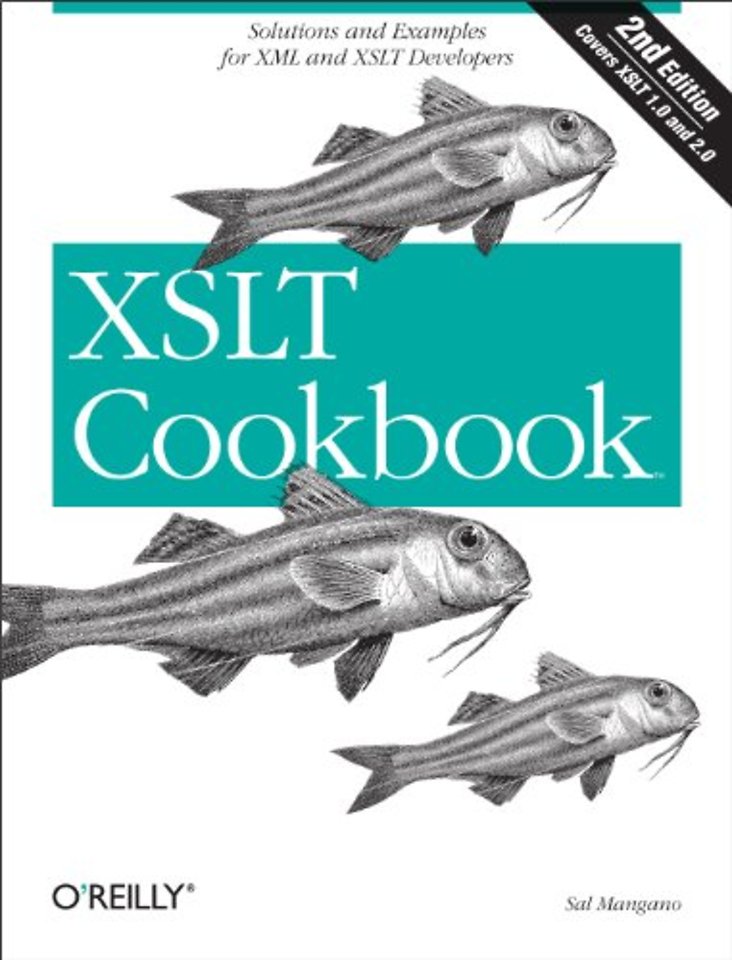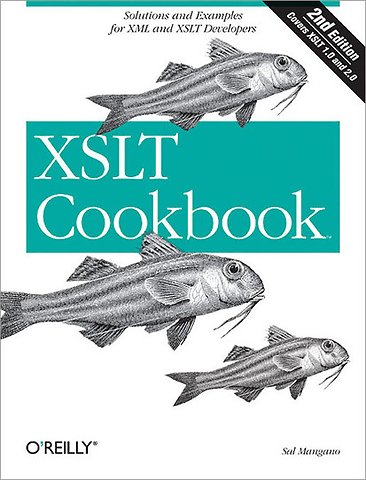


Sal Mangano has been developing software since the days Borland Turbo C and has worked with an eclectic mix of programming languages and technologies.
Meer over Sal ManganoXSLT Cookbook
Solutions and Examples for XML and XSLT Developers Covers XSLT 1.0 and 2.0)
Samenvatting
Extensible Stylesheet Language Transformation (XSLT) has become a key tool fort processing XML, but many developers still find it daunting, and easier to tweak than to create from scratch. XSLT 2.0 addresses many key challenges, bur it has its own learning curve and isn't widely supported yet.
The 'XSLT Cookbook, 2nd Edition' offers hundreds of solutions to problems that developers regularly face in both versions 1.0 and 2.0. Recipes range from simple string manipulation and mathematical processing to more complex topics such as extending XSLT,. Testing and debuggi8ng XSLT stylesheets, and creating graphics with SVG. Each recipe walks through a problem and a solution, with explanations of the choices made and techniques uses in creating that solution. Many recipes include alternate solutions and explore issues such as convenience and performance.
Topics covered include:
- Manipulating strings
- Processing math
- Handling date and time
- Selecting content in source documents
- Managing tree manipulation
- Converting from XML to plain text
- Tweaking XML documents with stylesheets
- Using XSLR to query XML documents
- Generating HTML with XSLT
- Designing effective XPath
- Creating charts and graphs with SVG and XSLT
- Generating C and XSLT code using XSLT
- Processing Visio and Excel documents in XSLT
- Using XSLT to create SOAP documentation from WSDL
- Extending XSLT with additional functions
- Embedding XSLT in other processing
- Testing and debugging XSLT stylesheets
- Creating generic XSLT processors that work on many XML vocabularies
With recipes for all levels the 'XSLT Cookbook, 2nd Edition' provides an ideal companion for developers who want to learn by example. Whether you are just now figuring out XSLT's template-based approach or you already know XSLT and want a collection of quickly reusable recipes for more advanced tasks, the recipes in this cookbook will guide you through many different ways of applying XSLT.
Specificaties
Inhoudsopgave
1. XPath
-Introduction
-Effectively Using Axes
-Filtering Nodes
-Working with Sequences
-Shrinking Conditional Code with If Expressions
-Eliminating Recursion with for Expressions
-Taming Complex Logic Using Quantifiers
-Using Set Operations
-Using Node Comparisons
-Coping with XPath 2.0's Extended Type System
-Exploiting XPath 2.0's Extended Type System
2. Strings
-Introduction
-Testing If a String Ends with Another String
-Finding the Position of a Substring
-Removing Specific Characters from a String
-Finding Substrings from the End of a String
-Duplicating a String N Times
-Reversing a String
-Replacing Text
-Converting Case
-Tokenizing a String
-Making Do Without Regular Expressions
-Exploiting Regular Expressions
-Using the EXSLT String Extensions
3. Numbers and Math
-Introduction
-Formatting Numbers
-Rounding Numbers to a Specified Precision
-Converting from Roman Numerals to Numbers
-Converting from One Base to Another
-Implementing Common Math Functions
-Computing Sums and Products
-Finding Minimums and Maximums
-Computing Statistical Functions
-Computing Combinatorial Functions
-Testing Bits
4. Dates and Times
-Introduction
-Calculating the Day of the Week
-Determining the Last Day of the Month
-Getting Names for Days and Months
-Calculating Julian and Absolute Day Numbers from a Specified Date
-Calculating the Week Number for aSpecified Date
-Working with the Julian Calendar
-Working with the ISO Calendar
-Working with the Islamic Calendar
-Working with the Hebrew Calendar
-Formatting Dates and Times
-Determining Secular and Religious Holidays
5. Selecting and Traversing
-Introduction
-Ignoring Duplicate Elements
-Selecting All but a Specific Element
-Selecting Nodes by Context
-Performing a Preorder Traversal
-Performing a Postorder Traversal
-Performing an In-Order Traversal
-Performing a Level-Order Traversal
-Processing Nodes by Position
6. Exploiting XSLT 2.0
-Introduction
-Convert Simple Named Templates to XSLT Functions
-Prefer for-each-group over Muenchian Method of Grouping
-Modularizing and Modes
-Using Types for Safety and Precision
-Avoiding 1.0 to 2.0 Porting Pitfalls
-Emulating Object-Oriented Reuse and Design Patterns
-Processing Unstructured Text with Regular Expressions
-Solving Difficult Serialization Problems with Character Maps
-Outputting Multiple Documents
-Handling String Literals Containing Quote Characters
-Understanding the New Capabilities of Old XSLT 1.0 Features
7. XML to Text
-Introduction
-Dealing with Whitespace
-Exporting XML to Delimited Data
-Creating a Columnar Report
-Displaying a Hierarchy
-Numbering Textual Output
-Wrapping Text to a Specified Width and Alignment
8. XML to XML
-Introduction
-Converting Attributes to Elements
-Converting Elements to Attributes
-Renaming Elements or Attributes
-Merging Documents with Identical Schema
-Merging Documents with Unlike Schema
-Splitting Documents
-Flattening an XML Hierarchy
-Deepening an XML Hierarchy
-Reorganizing an XML Hierarchy
9. Querying XML
-Introduction
-Performing Set Operations on Node Sets
-Performing Set Operations on Node Sets Using Value Semantics
-Determining Set Equality by Value
-Performing Structure-Preserving Queries
-Joins
-Implementing the W3C XML Query-UseCases in XSLT
10. XML to HTML
-Introduction
-Using XSLT as a Styling Language
-Creating Hyperlinked Documents
-Creating HTML Tables
-Creating Frames
-Creating Data-Driven Stylesheets
-Creating a Self-Contained HTML Transformation
-Populating a Form
11. XML to SVG
-Introduction
-Transforming an Existing Boilerplate SVG
-Creating Reusable SVG Generation Utilities for Graphs and Charts
-Creating a Tree Diagram
-Creating Interactive SVG-Enabled Web Pages
12. Code Generation
-Introduction
-Generating Constant Definitions
-Generating Switching Code
-Generating Message-Handling Stub Code
-Generating Data Wrappers
-Generating Pretty Printers
-Generating a Test Data-Entry Web Client
-Generating Test-Entry Web CGI
-Generating Code from UML Models via XMI
-Generating XSLT from XSLT
13. Vertical XSLT Application Recipes
-Introduction
-Converting Visio VDX Documents to SVG
-Working with Excel XML Spreadsheets
-Generating XTM Topic Maps from UML Modelsvia XMI
-Generating Web Sites from XTM Topic Maps
-Serving SOAP Documentation from WSDL
14. Extending and Embedding XSLT
-Introduction
-Saxon Extension Functions
-Saxon Extension Elements
-Xalan-Java 2 Extension Functions
-Java Extension Function Using the Class Format Namespace
-Java Extension Function Using the Package Format Namespace
-Java Extension Function Using the Java Format Namespace
-Scripting Extension Function Using Inline Script Code
-Xalan-Java 2 Extension Elements
-Java Extension Element
-Scripting Extension Elements
-MSXML Extension Functions
-Using Saxon's and Xalan's Native Extensions
-Extending XSLT with JavaScript
-Adding Extension Functions Using Java
-Adding Extension Elements Using Java
-Using XSLT from Perl
-Using XSLT from Java
15. Testing and Debugging
-Introduction
-Using xsl:message Effectively
-Tracing the Flow of Your Stylesheet Through Its Input Document
-Automating the Insertion of Debug Output
-Including Embedded Unit Test Data in Utility Stylesheets
-Structuring Unit Tests
-Testing Boundary and Error Conditions
16. Generic and Functional Programming
-Introduction
-Creating Polymorphic XSLT
-Creating Generic Element Aggregation Functions
-Creating Generic Bounded Aggregation Functions
-Creating Generic Mapping Functions
-Creating Generic Node-Set Generators
Index
Anderen die dit boek kochten, kochten ook
Net verschenen
Rubrieken
- aanbestedingsrecht
- aansprakelijkheids- en verzekeringsrecht
- accountancy
- algemeen juridisch
- arbeidsrecht
- bank- en effectenrecht
- bestuursrecht
- bouwrecht
- burgerlijk recht en procesrecht
- europees-internationaal recht
- fiscaal recht
- gezondheidsrecht
- insolventierecht
- intellectuele eigendom en ict-recht
- management
- mens en maatschappij
- milieu- en omgevingsrecht
- notarieel recht
- ondernemingsrecht
- pensioenrecht
- personen- en familierecht
- sociale zekerheidsrecht
- staatsrecht
- strafrecht en criminologie
- vastgoed- en huurrecht
- vreemdelingenrecht





